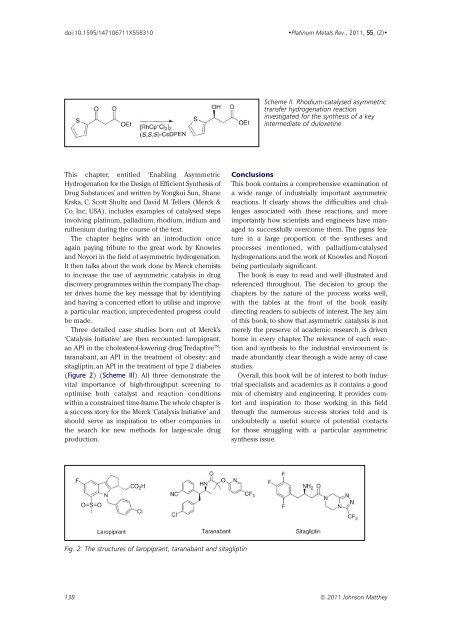Download - Platinum Metals Review
Download - Platinum Metals Review
Download - Platinum Metals Review
Create successful ePaper yourself
Turn your PDF publications into a flip-book with our unique Google optimized e-Paper software.
doi:10.1595/147106711X558310<br />
•<strong>Platinum</strong> <strong>Metals</strong> Rev., 2011, 55, (2)•<br />
Scheme II. Rhodium-catalysed asymmetric<br />
transfer hydrogenation reaction<br />
investigated for the synthesis of a key<br />
intermediate of duloxetine<br />
This chapter, entitled ‘Enabling Asymmetric<br />
Hydrogenation for the Design of Efficient Synthesis of<br />
Drug Substances’ and written by Yongkui Sun, Shane<br />
Krska, C. Scott Shultz and David M. Tellers (Merck &<br />
Co, Inc, USA), includes examples of catalysed steps<br />
involving platinum, palladium, rhodium, iridium and<br />
ruthenium during the course of the text.<br />
The chapter begins with an introduction once<br />
again paying tribute to the great work by Knowles<br />
and Noyori in the field of asymmetric hydrogenation.<br />
It then talks about the work done by Merck chemists<br />
to increase the use of asymmetric catalysis in drug<br />
discovery programmes within the company.The chapter<br />
drives home the key message that by identifying<br />
and having a concerted effort to utilise and improve<br />
a particular reaction, unprecedented progress could<br />
be made.<br />
Three detailed case studies born out of Merck’s<br />
‘Catalysis Initiative’ are then recounted: laropiprant,<br />
an API in the cholesterol-lowering drug Tredaptive TM ;<br />
taranabant, an API in the treatment of obesity; and<br />
sitagliptin, an API in the treatment of type 2 diabetes<br />
(Figure 2) (Scheme III). All three demonstrate the<br />
vital importance of high-throughput screening to<br />
optimise both catalyst and reaction conditions<br />
within a constrained time-frame.The whole chapter is<br />
a success story for the Merck ‘Catalysis Initiative’ and<br />
should serve as inspiration to other companies in<br />
the search for new methods for large-scale drug<br />
production.<br />
Conclusions<br />
This book contains a comprehensive examination of<br />
a wide range of industrially important asymmetric<br />
reactions. It clearly shows the difficulties and challenges<br />
associated with these reactions, and more<br />
importantly how scientists and engineers have managed<br />
to successfully overcome them. The pgms feature<br />
in a large proportion of the syntheses and<br />
processes mentioned, with palladium-catalysed<br />
hydrogenations and the work of Knowles and Noyori<br />
being particularly significant.<br />
The book is easy to read and well illustrated and<br />
referenced throughout. The decision to group the<br />
chapters by the nature of the process works well,<br />
with the tables at the front of the book easily<br />
directing readers to subjects of interest. The key aim<br />
of this book, to show that asymmetric catalysis is not<br />
merely the preserve of academic research, is driven<br />
home in every chapter. The relevance of each reaction<br />
and synthesis to the industrial environment is<br />
made abundantly clear through a wide array of case<br />
studies.<br />
Overall, this book will be of interest to both industrial<br />
specialists and academics as it contains a good<br />
mix of chemistry and engineering. It provides comfort<br />
and inspiration to those working in this field<br />
through the numerous success stories told and is<br />
undoubtedly a useful source of potential contacts<br />
for those struggling with a particular asymmetric<br />
synthesis issue.<br />
Fig. 2. The structures of laropiprant, taranabant and sitagliptin<br />
138 © 2011 Johnson Matthey
















